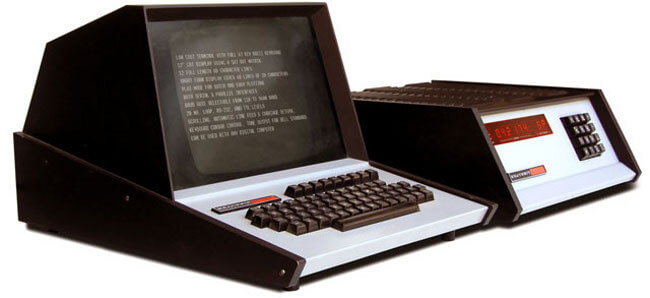- Get link
- X
- Other Apps
- Get link
- X
- Other Apps

Great breakthrough in computer technology has happened! And not for the first time. This happens periodically. This time, “we are introducing the Heathkit personal computer. New horizons of personal computing standards are opening up to us through two powerful computers equipped with exclusive software created by Heath. Service support is provided. The computer is accompanied by technical documentation.
That is how in 1977 Heathkit ("heath" - steppe; "kit" - set) described its debut in the computer market. The question is, what was the second computer? Is the H8 itself assembled? It must be said that a company with such an original name could boast of a history that goes back, if not back centuries, then at least rather respectable. Back in 1926, she released a light airplane in the form of a ... kit for self-assembly.
Among its products are equipment for testing audio systems and electronics and communication systems for radio amateurs that preceded mobile communications. H8 is the first computer from Heathkit.
Other companies also produced computers for craftsmen in the form of assembly kits. But gradually such sets lost their positions and gave way to finished products.

Heathkit H8 was introduced in July 1977, but went on sale only in the autumn of the same year. It was relatively inexpensive: $ 379. This price did not include the cost of RAM. Heathkit H8 could be equipped with RAM (RAM, RAM) from 4 to 64 kilobytes.
Heathkit H8 was based on the Intel 8080A processor, the clock frequency of which was 2 megahertz. A modern smartphone is hundreds of times more powerful. The Heathkit H8 input interface was a six-key keyboard, and the output was on a nine-digit display. The data could be read and recorded either on tape cassettes or (since 1978) on floppy disks (floppy disks). Operating system: HDOS (Heath DOS).
The Heathkit H8's not-too-high initial price included only the base and the central processing unit (CPU) card. Therefore, further expenses and considerable ones began. The 4-kbyte H8-1 memory board alone cost $ 140. And this is the minimum amount of memory. However, all the most important software for this computer is quite fit in this modest memory.
To use a cassette recorder as a drive, you had to spend another $ 110 on an H8-5 Serial I / O card. And in order to connect a floppy disk drive, it took as much as 16 kilobytes of RAM. It is terrible to even think how much technology was so high for its time.
It’s scary to think, but it’s necessary to get at least a partial idea of how Heathkit H8 was predatory towards the wallet of its user, who thought he had made a bargain without spending four hundred US dollars on a computer.

In 1978, a double floppy disk drive for this computer (or rather, a designer?) Cost $ 675. It goes without saying that a cassette tape recorder, which could be used as a budget drive, was not included in the kit and was also bought for some money (or was already available on the farm).
Now the fun part. Components for Heathkit H8 were not compatible with any computer, except for the one for which they were intended. However, in those days it was the most common practice. Although already then the first attempts at standardization in the computer field were made. The most vivid example of this is the system bus. Heathkit did not even want to think about third-party technologies and proudly developed its own 50-pin bus for its H8 with ten expansion slots.
It is clear that the 16-button keyboard was, let's say softly, not the most convenient input device, and the “calculator” display is not the best means of output, therefore, with considerable probability, the user would sooner or later have the idea of a terminal. The terminal consisted of a normal for its time display and a full keyboard, as well as a variety of electronic components that have no special significance for our narrative.
Thus, having bought Heathkit H8 profitably, the person was drawn into the “fascinating” game of consumption. Its essence was whether the user will be able to resist the temptation and spend less.

Concluding our story, let's see what the “thrifty” user Heathkit H8 could spend money on:
475 US dollars cost WH8, that is, assembled and tested Heathkit H8. For $ 140, the H8-1 was bought, that is, a static memory card, where 4 kilobytes of RAM were already installed and it was possible to install four more, eventually getting as many as eight. $ 95 cost the H8-3 RAM chip. It could be installed in the H8-1 board.
The H8-2 was a board with three parallel ports and cost the user $ 150. H8-5 was worth 110 dollars. This board contained serial input and output, as well as a cassette recorder connection interface. The data transfer rate was 1200 baud, that is, bits per second.
WH17 is a dual floppy drive. Contained one drive and I / O card. Required 16 kilobytes of RAM. It was the most expensive extension of Heathkit H8 and cost $ 675. There it was also possible (in WH17) to install a second H17-1 floppy disk drive for $ 295.
A pack of five 5.25-inch floppy disks (floppy disks) was mysteriously called H17-2 and cost $ 25. The software of the disk operating system was called H8-17 and cost one hundred dollars.
Yes, buying Heathkit H8, a person for a long time provided himself with an additional item of fixed costs.
Based on: oldcomputers.net
The article is based on materials .
- Get link
- X
- Other Apps
Comments
Post a Comment